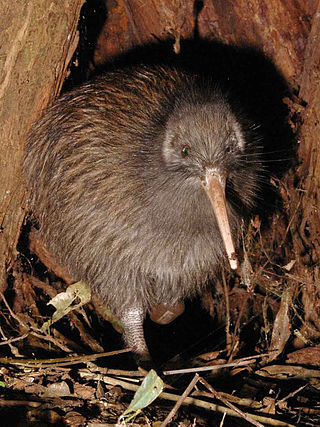
Kiwi are flightless birds endemic to New Zealand of the order Apterygiformes. The five extant species fall into the family Apterygidae and genus Apteryx. Approximately the size of a domestic chicken, kiwi are the smallest ratites.
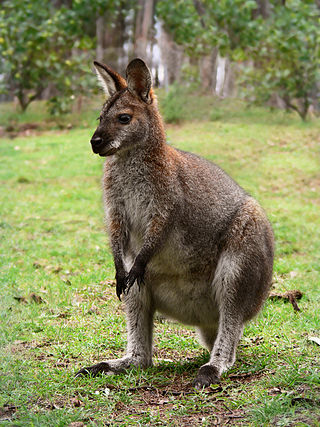
A wallaby is a small or middle-sized macropod native to Australia and New Guinea, with introduced populations in New Zealand, Hawaii, the United Kingdom and other countries. They belong to the same taxonomic family as kangaroos and sometimes the same genus, but kangaroos are specifically categorised into the four largest species of the family. The term "wallaby" is an informal designation generally used for any macropod that is smaller than a kangaroo or a wallaroo that has not been designated otherwise.

Rails are a large, cosmopolitan family of small- to medium-sized terrestrial and/or semi-amphibious birds. The family exhibits considerable diversity in its forms, and includes such ubiquitous species as the crakes, coots, and gallinule; other rail species are extremely rare or endangered. Many are associated with wetland habitats, some being semi-aquatic like waterfowl, but many more are wading birds or shorebirds. The ideal rail habitats are marsh areas, including rice paddies, and flooded fields or open forest. They are especially fond of dense vegetation for nesting. The rail family is found in every terrestrial habitat with the exception of dry desert, polar or freezing regions, and alpine areas. Members of Rallidae occur on every continent except Antarctica. Numerous unique island species are known.

The orthopteran family Rhaphidophoridae of the suborder Ensifera has a worldwide distribution. Common names for these insects include cave crickets, camel crickets, Hogan bugs, spider crickets, land shrimp, and sand treaders. Those occurring in New Zealand are typically referred to as jumping or cave wētā. Most are found in forest environments or within caves, animal burrows, cellars, under stones, or in wood or similar environments. All species are flightless and nocturnal, usually with long antennae and legs. More than 500 species of Rhaphidophoridae are described.

Nothofagus, also known as the southern beeches, is a genus of 43 species of trees and shrubs native to the Southern Hemisphere in southern South America and east and southeast Australia, New Zealand, New Guinea, and New Caledonia. The species are ecological dominants in many temperate forests in these regions. Some species are reportedly naturalised in Germany and Great Britain. The genus has a rich fossil record of leaves, cupules, and pollen, with fossils extending into the late Cretaceous period and occurring in Australia, New Zealand, Antarctica, and South America.
Hyposmocoma molluscivora is a Hawaiian moth whose larvae are predators, capturing snails in their silk, much like a hunting spider's web, and then crawling inside the snail's shell to eat it alive. It has been called the snail-eating caterpillar or the flesh-eating caterpillar, though no common name has been widely prescribed to it.

Asteliaceae is a family of flowering plants, placed in the order Asparagales of the monocots.

Prosqualodon is an extinct genus of Early to Middle Miocene cetacean from Argentina, Australia, New Zealand and Venezuela.

Arthur William Baden Powell was a New Zealand malacologist, naturalist and palaeontologist, a major influence in the study and classification of New Zealand molluscs through much of the 20th century. He was known to his friends and family by his third name, "Baden".
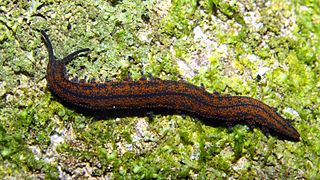
Peripatoides is a genus of velvet worms in the family Peripatopsidae, whose species are found in New Zealand. Like all velvet worms, these animals are nocturnal predators that spit a sticky slime to trap their prey. Species of Peripatoides have 14, 15, or 16 pairs of legs.

Achatinellidae is a family of tropical air-breathing land snails, terrestrial pulmonate gastropod mollusks in the superfamily Pupilloidea.
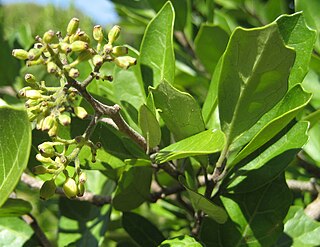
Pennantia is the sole genus in the plant family Pennantiaceae. In older classifications, it was placed in the family Icacinaceae. Most authorities have recognised three or four species, depending on whether they recognised Pennantia baylisiana as a separate species from Pennantia endlicheri. British-born botanist David Mabberley has recognised two species.

The Hymenogastraceae is a family of fungi in the order Agaricales with both agaric and false-truffle shaped fruitbodies. Formerly, prior to molecular analyses, the family was restricted to the false-truffle genera. The mushroom genus Psilocybe in the Hymenogastraceae is now restricted to the hallucinogenic species while nonhallucinogenic former species are largely in the genus Deconica classified in the Strophariaceae.

Corynocarpus is the only genus of plants in the family Corynocarpaceae and includes five species. It is native to New Guinea, Australia, New Zealand, New Caledonia, and Vanuatu.
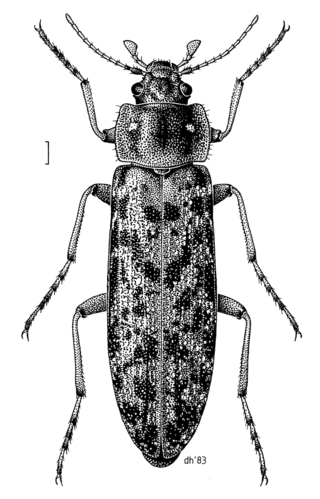
The Chalcodryidae are a family of beetles in the superfamily Tenebrionoidea. It contains at least five species in two genera Chalcodrya and Philpottia, which are endemic to New Zealand. They are generally found associated with moss or lichen covered branches, with the larvae having been found to be associated with dead twigs. It is thought that they are noctural, feeding on lichen and other plant material at night. The genera Sirrhas and Onysius, formerly placed in this family, have subsequently been transferred to Promecheilidae.
Hyposmocoma pupumoehewa is a species of moth of the family Cosmopterigidae. It is endemic to Maui.

Otekaikea is an extinct genus of toothed whale closely related to Waipatia. It is known from the late Oligocene (Chattian) of New Zealand.

Ooperipatellus is a genus of Australian and New Zealand velvet worms in the Peripatopsidae family. Species in this genus are oviparous. Most species in this genus have 14 pairs of legs, but O. nanus has only 13 pairs, which is the minimum number found in the phylum Onychophora. Velvet worms in this genus are among the smallest known, with adults often only 10 to 20 millimeters long. Morphological and molecular data indicate that this genus is a monophyletic group.
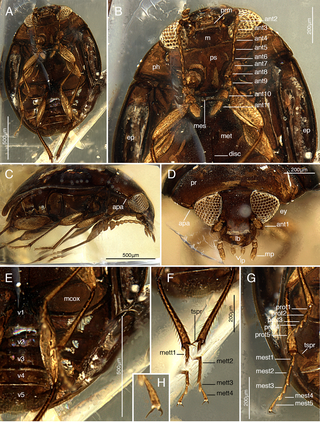
Cyclaxyridae are a family of beetles in the superfamily Cucujoidea. The only living genus is Cyclaxyra, with two species endemic to New Zealand. Other species have been named from fossils. They are also known as sooty mould beetles due to the association of Cyclaxyra with sooty mould. The extant species are mycophagous, feeding on spores, conidia, and hyphae.
















